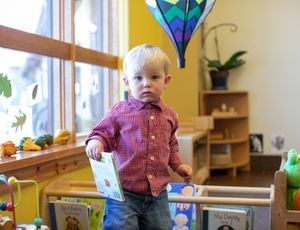Dr. Maria Montessori saw many similarities between toddlers and teenagers; both go through an enormous series of changes in their development: emotionally, psychologically, and physically. A toddler goes from non-mobile to independently moving, from being attached to mom or dad to wanting freedom to explore freely; they go from non-verbal to verbal, and both have big emotions they are learning to control. In this month’s article, we will explore the reason a toddler might bite and how we can help him understand and control his emotions in a respectful way.
Biting is very common among groups of toddlers for many different reasons. Most parents and caregivers find this way of communication shocking and disturbing. It usually leads to dramatic reactions of the adult, and there is a desire to stop it immediately. However, to adequately address biting, we need to understand why our child is doing it and how to intervene calmly.
Why does my child bite?
In infants, biting is a form of exploration. The mouth is a hypersensitive area that helps them to learn through their senses. Usually, infants will take items to their mouths and chew them to learn more about them. Infants also might bite something to relieve gum itchiness since their teeth are coming out.
Toddlers usually bite as a clear, effective way of communication. As mentioned before, they are going through many different changes in their development and they have big emotions. They react to frustration because they might not have the language skills to control a situation yet. They have limited ability to wait, they naturally do not share, and most of them do not understand cause and consequence. All of these situations are completely normal for their development.
Here are the most common reasons a toddler might bite:
- To experiment: Some toddlers are still relying mainly on their mouth to discover the world.
- To express: When a toddler cannot communicate himself orally, he will look for other forms like using his body language, which might include biting.
- To test: Some toddlers explore cause and effect in the environment; just like they explore how far they can go with the adult, they might explore how far they can go with primitive ways of communication.
- For teething: Toddlers might find relief putting pressure on their gums to relieve the pain of new teeth coming up.
- Because of frustration: Toddlers have not developed patience, self-regulation, or waiting skills yet. If they get bored, angry, or tired, they might respond with biting to express their frustration.
- Because of fear: When a toddler feels in danger or overstimulated by the environment or events of his life, he might bite as self-defense.
- To imitate: Many toddlers imitate social behaviors they see. This is most often seen in group environments like daycares or schools where a peer bites and the child decides to imitate him.
- To seek attention: When parents give a lot of attention to a negative behavior the biting is reinforced. Opt to provide lots of attention to a positive behavior instead.
- For power: Some toddlers will use biting as a way of satisfying their need for independence and control. Let him make many decisions during the day, so he does not need to use biting as the only tool to show control.
How to prevent biting
- Make sure your toddler has enough space to move around and explore to avoid frustration.
- Keep a calm auditory environment and avoid overstimulating your child with excessive sounds. For instance: Many people talking at loudly, the television on, music playing in the background, and even windows open when ambulances or construction work can be heard. All of this can impact the calmness anyone has, especially a toddler.
- Keep a routine, be flexible when needed, but try to keep it as consistent as possible. Your child will be able to anticipate what is coming next without any frustration.
- Provide enough toys or materials for him to use, and make sure all of them are adequate for his age. Avoid giving him too many options since that can also overstimulate him.
- Observe and keep an eye on your child if you notice he is getting frustrated so you can intervene calmly before any biting happens.
- Decode feelings and help him put a name to the emotions he is feeling. Validate how he is feeling with expressions like: “Andy, I can see you are frustrated because Tom is using the red ball,” and offer a choice.
- Understand the capability of your toddler and adjust your expectations. For instance, don’t expect your toddler to wait 45 minutes quietly seated while you go to an appointment. The odds are that he will get very frustrated and will find ways to communicate his frustration.
How to respond to a bite
- Respond immediately but calmly.
- Focus your attention on the child who was bitten. Provide comfort to the child.
- Use accurate language towards the action, not your child. “That hurt,” instead of “You hurt your friend!” It is crucial that we keep in mind that biting is not the fault of the child; he does not do it to hurt anyone. So be very mindful to always refer to the behavior, not the child.
- Ask your toddler if he wants to comfort the bitten child by bringing an ice pack or rubbing his back, but do not demand that he apologize because that might get him more frustrated.
- Calmly state expectations and limits that we do not bite or hurt others. Use simple expressions since toddlers respond better to short explanations than longer ones.
- If you observe that your toddler is biting because he is seeking relief from teething, offer him something else to bite and put pressure on his gums. For instance: cold teething toys, wooden spoons, etc.
- By all means, avoid hitting or biting a child who has bitten. That will teach him that violence is okay.
Item of the Month
Balance Bike for Toddlers
This is a bike with no pedals that is designed for toddlers to develop balance and coordination. Its low height allows it to be safe for children to lift their feet without exposing them to dangerous situations. There is no adult intervention necessary for the child to use the bike.
Link to buy it at Amazon:
https://www.amazon.com/Schwinn-Toddler-Balance-Beginner-Training/dp/B01H4UDQ04/ref=redir_mobile_desktop?ie=UTF8&aaxitk=rT5wW7jDTrz1p-CRCOxd.Q&hsa_cr_id=6175783080001&ref_=sbx_be_s_sparkle_mcd_asin_0
Book of the Month
The Emotional Life of the Toddler by Alicia F. Lieberman
Many books talk about the physical and cognitive development of toddlers, but few authors talk about the emotional development which impacts their everyday life. The more we understand such an essential part of their development, the more we will be able to support them and foster their healthy relationships and elevate their self-image.
Link to buy it at Amazon.com:
https://www.amazon.com/Emotional-Life-Toddler-Alicia-Lieberman/dp/1476792038/ref=sr_1_1?dchild=1&keywords=The+Emotional+Life+of+the+Toddler+by+Alicia+F.+Lieberman&qid=1594824053&s=books&sr=1-1
Have a Little extra time?
Grab your headphones and listen to this 15-minutes podcast by Janet Lansbury. She reads a letter she received from a dad that wants to help his toddler that is showing aggressive behavior like biting and hitting. Janet talks about a respectful approach to the toddler, the proper communication to be used, and the benefits of addressing these behaviors calmly. Enjoy!
Link to podcast at soundcloud.com
https://soundcloud.com/janet-lansbury/aggressive-toddler-behavior-hitting-biting-spitting



